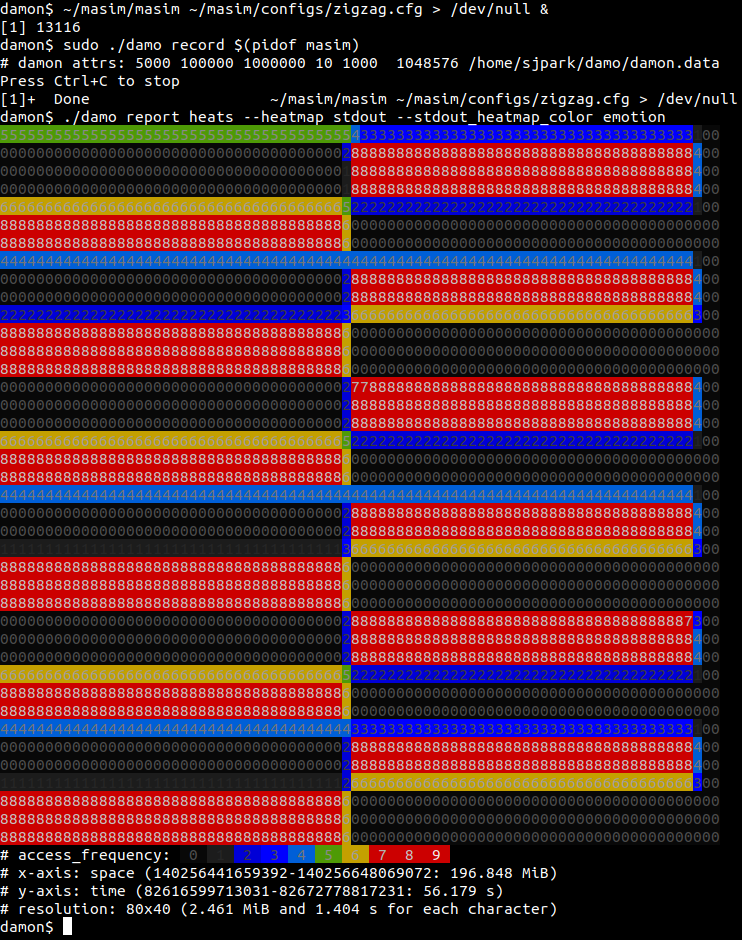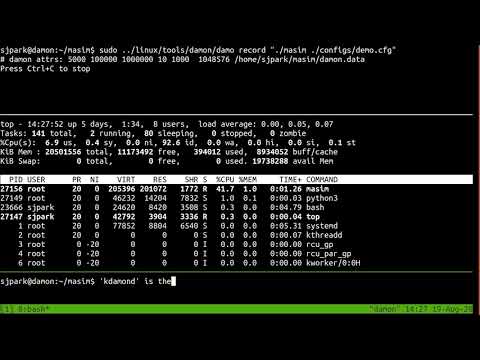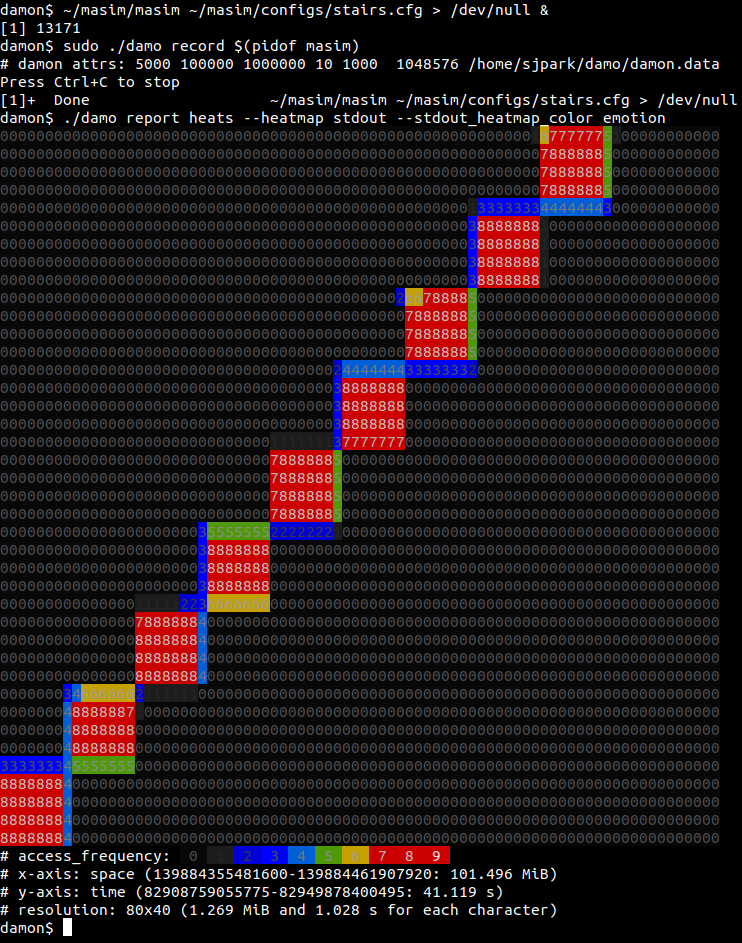DAMON user-space tool
Project description
DAMO: Data Access Monitoring Operator
damo is a user space tool for DAMON. Using
this, you can monitor the data access patterns of your system or workloads and
make data access-aware memory management optimizations.
Demo Video
Please click the below thumbnail to show the short demo video.
Getting Started
Follow below instructions and commands to monitor and visualize the access pattern of your workload.
$ # ensure your kernel is built with CONFIG_DAMON_*=y
$ sudo pip3 install damo
$ sudo damo record $(pidof <your workload>)
$ damo report heats --heatmap stdout --stdout_heatmap_color emotion
The last command will show the access pattern of your workload, like below:

FAQs
How can I install a kernel that is built with CONFIG_DAMON_*=y?
Please refer to 'Install' section of the project webpage.
Where can I get more detailed usage?
The below sections provide quick introductions for damo's major features.
For more detailed usage, please refer to USAGE.md file.
What does the version number mean?
Nothing at all but indicate which version is more fresh. A higher version number means it is more recently released.
Will pip3 install damo install the latest version of damo?
It will install the latest stable version of damo. If you want, you can
also install less stable but more fresh damo from source code. For that,
fetch the next branch of the source tree and use damo executable file in
the tree.
$ git clone https://github.com/awslabs/damo -b next
How can I participate in the development of damo?
Please refer to CONTRIBUTING file.
I show --rbuf option from damo record is removed. What happened?
The option is deprecated. Please report your usecase to sj@kernel.org, damon@lists.linux.dev and linux-mm@kvack.org if you depend on those.
damo suddenly exit with You're using unsupported DAMOS format message. Why?
Because the DAMOS input you're using is no more supported. Please report your usecase to sj@kernel.org, damon@lists.linux.dev and linux-mm@kvack.org if you depend on those.
Recording Data Access Patterns
Below commands record memory access patterns of a program and save the
monitoring results in damon.data file.
$ git clone https://github.com/sjp38/masim
$ cd masim; make; ./masim ./configs/zigzag.cfg &
$ sudo damo record -o damon.data $(pidof masim)
The first two lines of the commands get an artificial memory access generator
program and run it in the background. It will repeatedly access two 100
MiB-sized memory regions one by one. You can substitute this with your real
workload. The last line asks damo to record the access pattern in
damon.data file.
Visualizing Recorded Patterns
Below three commands visualize the recorded access patterns into three image files.
$ damo report heats --heatmap access_pattern_heatmap.png
$ damo report wss --range 0 101 1 --plot wss_dist.png
$ damo report wss --range 0 101 1 --sortby time --plot wss_chron_change.png
access_pattern_heatmap.pngwill show the data access pattern in a heatmap, which shows when (x-axis) what memory region (y-axis) is how frequently accessed (color).wss_dist.pngwill show the distribution of the working set size.wss_chron_change.pngwill show how the working set size has chronologically changed.
You can show the images on a web page [1]. Those made with other realistic workloads are also available [2,3,4].
[1] https://damonitor.github.io/doc/html/latest/admin-guide/mm/damon/start.html#visualizing-recorded-patterns
[2] https://damonitor.github.io/test/result/visual/latest/rec.heatmap.1.png.html
[3] https://damonitor.github.io/test/result/visual/latest/rec.wss_sz.png.html
[4] https://damonitor.github.io/test/result/visual/latest/rec.wss_time.png.html
Data Access Pattern Aware Memory Management
Below three commands make every memory region of size >=4K that hasn't accessed for >=60 seconds in your workload to be swapped out. By doing this, you can make your workload more memory efficient with only a modest performance overhead.
$ sudo damo schemes --damos_access_rate 0 0 --damos_sz_region 4K max \
--damos_age 60s max --damos_action pageout \
<pid of your workload>
Note: Previously, one-line scheme specification format like below was used. It is now deprecated, and the support will be removed by 2023 Q2. Please report your usecase to sj@kernel.org, damon@lists.linux.dev and linux-mm@kvack.org if you depend on those.
$ echo "#min-size max-size min-acc max-acc min-age max-age action" > my_scheme
$ echo "4K max 0 0 60s max pageout" >> my_scheme
$ sudo damo schemes -c my_scheme <pid of your workload>
Project details
Release history Release notifications | RSS feed
Download files
Download the file for your platform. If you're not sure which to choose, learn more about installing packages.














